Puppy PreSchool
Laymani puppies are in training from day-one, with exposure to new textures and sounds starting from the very beginning. Their nursery is in their own puppy room, and we keep a close eye on things via video monitor. Mom will spend most of her time indoors, though we have a crate in another room for her to provide some respite from puppies.
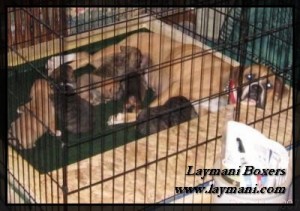
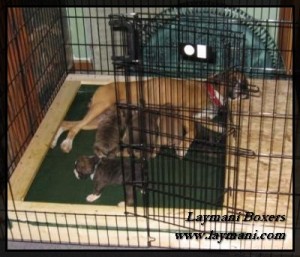 Our whelping box was designed with a top rail to prevent puppies from being squashed when Mom lies down. That same rail becomes a three-inch-high exercise rail at about 2.5 weeks. We also added a 12″ sanded oriented-strand-board shelf on one side of the box to provide a climbing spot and a new texture for the puppies to explore. Since these photos were taken, we have progressed to PVC bumper rails and a tarp-covered base.
Our whelping box was designed with a top rail to prevent puppies from being squashed when Mom lies down. That same rail becomes a three-inch-high exercise rail at about 2.5 weeks. We also added a 12″ sanded oriented-strand-board shelf on one side of the box to provide a climbing spot and a new texture for the puppies to explore. Since these photos were taken, we have progressed to PVC bumper rails and a tarp-covered base.
The whelping box is surrounded by a wire enclosure, so the puppies are easily in our sight all the time. Although they are in a separate room for quiet time with Mom, they have the advantage of exposure to the regular sights, sounds and smells of home-life.
Bath time means individual attention and a wipe-down with baby wipes. Of course, the whole process is about bonding with humans, association with voices, tolerance to touch, and puppy confidence. We do our best to make each new experience positive.
Puppy pads (a flat square of diaper-like material) have been in the whelping box since the puppies began to scoot on their front legs. They introduce a new smell and texture, while beginning the bathroom training process.
People-play begins with Denise and I in the first couple of days. One of our Laymani Mommas is now positioned with our daughter, Kristie, who has a whole family to play with future puppies.
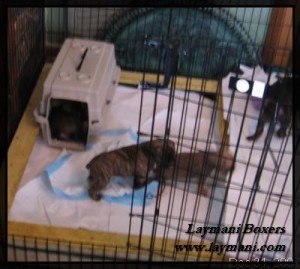
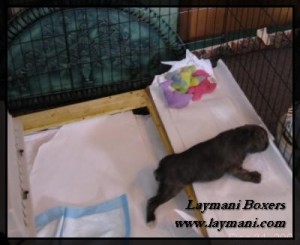 Life goes on as normal, even when new puppies are in the house. Music or TV is playing most of the time. We still have company over to play cards and cuddle a puppy. At the 2-week mark, this litter was exposed to a dinner for 16 people. Although we kept the puppies in the dining room that evening, they were exposed to the smells of food preparation and the sounds of all those people in the house.
Life goes on as normal, even when new puppies are in the house. Music or TV is playing most of the time. We still have company over to play cards and cuddle a puppy. At the 2-week mark, this litter was exposed to a dinner for 16 people. Although we kept the puppies in the dining room that evening, they were exposed to the smells of food preparation and the sounds of all those people in the house.
With 3-week-old mobile puppies, the realm of new experiences really begins to expand. Since our puppies will probably be crated in their future homes, they need time and exposure to develop confidence in entering “the box”. By the time they are ready to travel, their crate should be accepted as the equivalent of a den…a safe-place. Starter crate training is expected to be a rousing success! With Sissy’s Christmas litter, Denise removed the swing-gate and all six puppies piled inside. They immediately decided that the crate was their new best-place within the puppy box.
PreSchool is about learning, but it is also about play and interaction. An assortment of squeakies and cloth toys are ready to be introduced. Sibling play and interaction with Mom are also an important part of the next few weeks. A well-balanced adult will know how to safely play with others by practice and by Mom’s discipline.
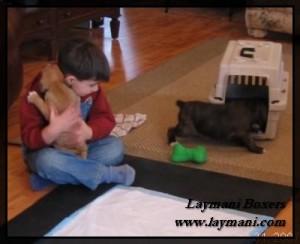
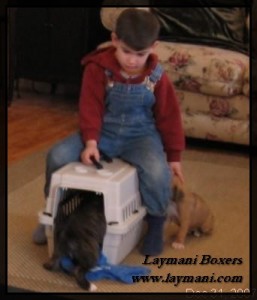 Bowl training begins a few days after the puppies have cut teeth. We begin with a little water in a shallow puppy bowl and soon progress to a preparation of the highest quality dry food moistened with water. At 4 weeks, all the puppies are eating moistened food twice a day. They eat with gusto and leave their box an awful mess. They also have fresh water available all the time. Mom only wants to feed them a couple times a day, as she begins weaning process.
Bowl training begins a few days after the puppies have cut teeth. We begin with a little water in a shallow puppy bowl and soon progress to a preparation of the highest quality dry food moistened with water. At 4 weeks, all the puppies are eating moistened food twice a day. They eat with gusto and leave their box an awful mess. They also have fresh water available all the time. Mom only wants to feed them a couple times a day, as she begins weaning process.
Manicures begin when the puppies’ nails are bothering Mom. Those sharp curly tips need to be snipped off regularly or Mom will want to avoid her scratching monsters.
As balance improves in the 4th week, our puppies begin climbing onto their shelf and even walking the 3.5-inch rail around the top of the puppy box. They often finish their act by diving onto the top of a puppy pile in the middle of their whelping box. Play interaction with siblings increases as their coordination improves. Puppies become very active and very mobile.
The small puppy carrier is easily moved from their box to the open floor and is quickly recognized as a safe place to get away from the action or take a snooze by all of the puppies. Our puppies like to be held and enjoy our attention. By 5 weeks of age, they are really into mock-battles with siblings and seeing all the new parts of the house.
Meals soon progress to dry Puppy Chow, though Mom still tolerates several very short feedings a day. Toys and towels have become important play items. Our first puppy toys are stuffed cloth squeakers, because they are soft enough for new puppy teeth and easily washed.
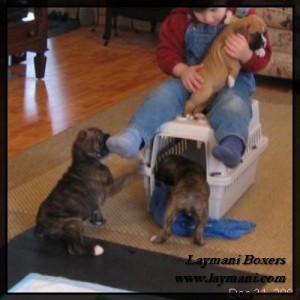
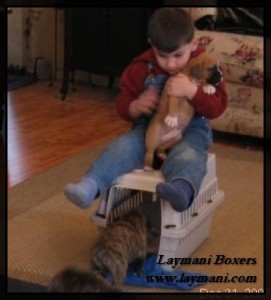 From 5 weeks until they go to their permanent home, the puppies are growing, growing, growing. They scamper, leap, jump, climb, and wrassle with each other. This period shows continuing growth in agility and personality. The puppies learn about friendly play and exploration. Mom teaches them about dog-rules with a gentle paw-cuff or some tussling of her own. They actively seek human interaction and love to cuddle.
From 5 weeks until they go to their permanent home, the puppies are growing, growing, growing. They scamper, leap, jump, climb, and wrassle with each other. This period shows continuing growth in agility and personality. The puppies learn about friendly play and exploration. Mom teaches them about dog-rules with a gentle paw-cuff or some tussling of her own. They actively seek human interaction and love to cuddle.